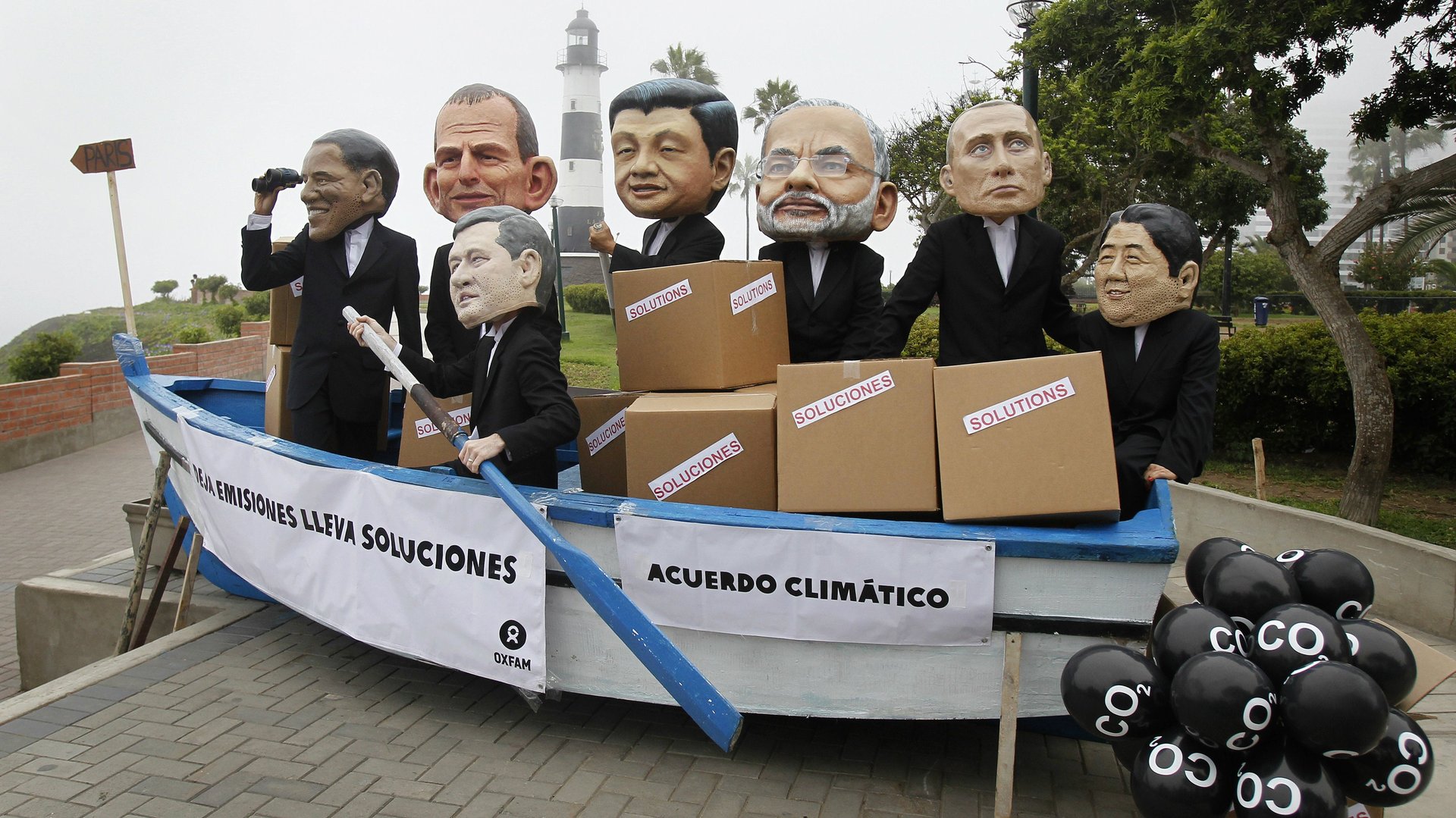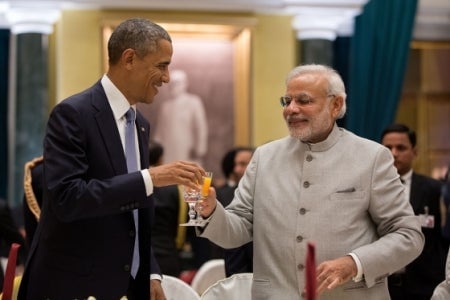Obama just found a new partner in the global warming fight: Modi
Relations between the US and India are warmer now than they have been in a long time. Could the budding cordiality in the relationship between president Obama and India’s recently-elected prime minister, Narendra Modi, help to slow global warming?


Relations between the US and India are warmer now than they have been in a long time. Could the budding cordiality in the relationship between president Obama and India’s recently-elected prime minister, Narendra Modi, help to slow global warming?
It’s too early to categorically answer that question in the affirmative. But it’s certainly starting to look that way.

Obama traveled to New Delhi over the weekend for a trip that was coincided with India’s annual celebration of its constitution, Republic Day. Prior to the rain-soaked celebrations, the two world leaders held a joint press conference and issued a joint statement—both referencing agreements regarding clean energy and climate change.
Obama’s Indian excursion was the second of his presidency—and it was an important diplomatic venture that seems certain to improve the future of Indian and American relations. Here’s an explanation of what the trip could mean for the very future of the planet.
How important was this trip for Modi?
Modi has been prime minister for less than a year, and this was already his second meeting with Obama—the first was in September in Washington, DC. Did Obama mispronounce Modi’s name during those initial meetings? Did he perhaps slip up and call him “Moby,” and apologize for not buying any of his records since 1999? If so, Modi’s curious choice of attire could make sure that won’t happen again. For his Obama meeting, Modi wore a suit, tailored especially for the occasion, featuring pin stripes fashioned out of the repeated spelling of his own name—in English.
What should Obama’s suit have said?
“Cajoller-In-Chief.”
Well into his second term, Obama started acting on climate change, turning his nation from a global climate pariah into an emerging climate leader. Obama has been trying to encourage other countries to reduce their own greenhouse gas pollution levels, and to commit to doing so through the UN climate negotiations. Following the failures of the Kyoto Protocol, which tried but failed to mandate meaningful pollution reductions, the negotiations have become a cajoling process, with countries trying to pressure each other to voluntarily commit to ambitious reductions. Nearly 200 countries plus the European Union are due to announce their planned reductions under the next climate pact this year, and few world leaders have been doing as much of the cajoling ahead of the announcements as Obama.
Was Modi cajoled?
Each of India’s 1.2 billion residents has, on average, a comparatively small impact on the climate. That’s partly because of poverty, with some 400 million still lacking access to electricity. But there are so many Indians, and their economy is growing so steadily—mostly powered by burning heavily polluting coal—that India is now producing more climate pollution every day than any other country except for China and the US—and its emission are growing quickly, with no plateau in sight.

For years, India’s leaders have obstructed a variety of climate talks, including those that attempted to reduce the use of climate-changing refrigerants, and long insisted that climate action was solely the responsibility of richer countries. Since taking office, Modi has sent confusing mixed messages on climate change. A top priority for his negotiators during climate negotiations in Peru last month was to extend a decades-old differentiation between the climate-stabilizing responsibilities of rich and poor countries. After meeting with Obama over the weekend, though, Modi seemed clearer than a hazy Delhi day on the risks posed by global warming.
“India is an independent country, and there is no pressure on us from any country or any person,” Modi said during the joint press conference, after he was asked whether the recent US-China climate deal put pressure on India to agree to something similar. “But there is pressure. When we think about the future generations and what kind of world we are going to give them, then there is pressure. Climate change itself is a huge pressure.”
Upon what did the world leaders agree?
A joint US-India statement published by the White House over the weekend listed 59 points of agreement, many of them focused on defense, security and trade. The climate and energy agreements were way down the list, numbered 43, 44 and 45. Those agreements will make it easier for American nuclear energy suppliers to do business in India, they reiterate American intentions to provide financing and other support for billions of dollars worth of clean energy projects, and they commit to working internationally to reduce the use of chemicals known as HFCs, which are climate-unfriendly refrigerants.
Perhaps most importantly, though, the duo pledged to work together to make the next UN climate pact a valuable one.
“President Obama and Prime Minister Modi share a deep concern regarding the climate challenge and understand that meeting it will require concerted action by their countries and the international community,” the joint statement said. “They also stressed the importance of working together and with other countries to conclude an ambitious climate agreement in Paris in 2015. To this end, they plan to cooperate closely over the next year to achieve a successful agreement in Paris.”
Is that just a lot of hot air?
It is a lot of talk—but talk is important as countries gear up for the critical round of climate negotiations in Paris at the end of this year. Experts say the energy-related agreements between India and the US are more than that, though. They include meaningful measures for reducing pollution and stimulating India’s emerging green economy.
“The nuclear deal, as well as the pledges to help India with other renewables, could turn out to be quite important,” Rob Stavins, an economics professor at Harvard University who has long been involved with the UN climate talks, said.
“The explicit climate aspects are obviously less dramatic and less significant than the joint China-USA announcement from last November,” Stavins said. “It was recognized from early on that a ‘China-like’ commitment from India was not feasible, both because of India’s very different economic circumstances, compared with China, and because of the differences in domestic politics—namely, India is a democracy, and with a populist government and prime minister.”
Why would a fast-growing economy need foreign financing?
It’s not just India that needs climate and clean-energy financing. The need among poor and developing countries for international financial help in meeting their growing energy needs without blowing out the climate is one of the biggest sticking points in the UN climate negotiations.
India has wildly ambitious solar and wind energy goals, which were put in place largely to help provide the country’s impoverished residents with reliable electricity supplies. But it can’t afford to pay up front for the new wind turbines and solar panels needed to meet the goal of producing 100 gigawatts of clean electricity by 2022.
The US Export-Import Bank, which helps bankroll business ventures that benefit American businesses abroad, is planning to provide India with $1 billion in low-interest loans earmarked for renewable energy projects. That sounds like a gush of money, but it’s a relative drip when compared with the $7.9 billion in clean energy investments made in India last year, much of which came from foreign companies and investors.
“The Indian market is a huge opportunity for American businesses involved in renewable energy technology,” Anjali Jaiswal, director of the Natural Resources Defense Council’s India Initiative, said. “Because India is still a developing country, the cost of capital is still very high.”
Can we now expect India to be a global climate leader?
Trying to predict where India will swerve on climate policy seems as hard as predicting which way an auto-rickshaw driver will swerve in a Kolkata traffic jam.
“Overall, we’re still holding our breath, waiting to see what Modi and India are going to do on greenhouse gas emissions and climate,” Heather Coleman, Oxfam America’s climate policy leader, said. “I don’t think this announcement sheds more light on that.”
This post originally appeared at Climate Central. We welcome your comments at [email protected].